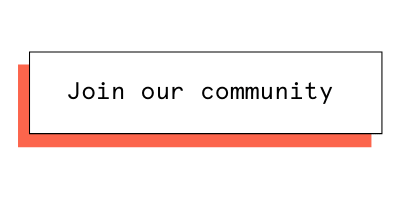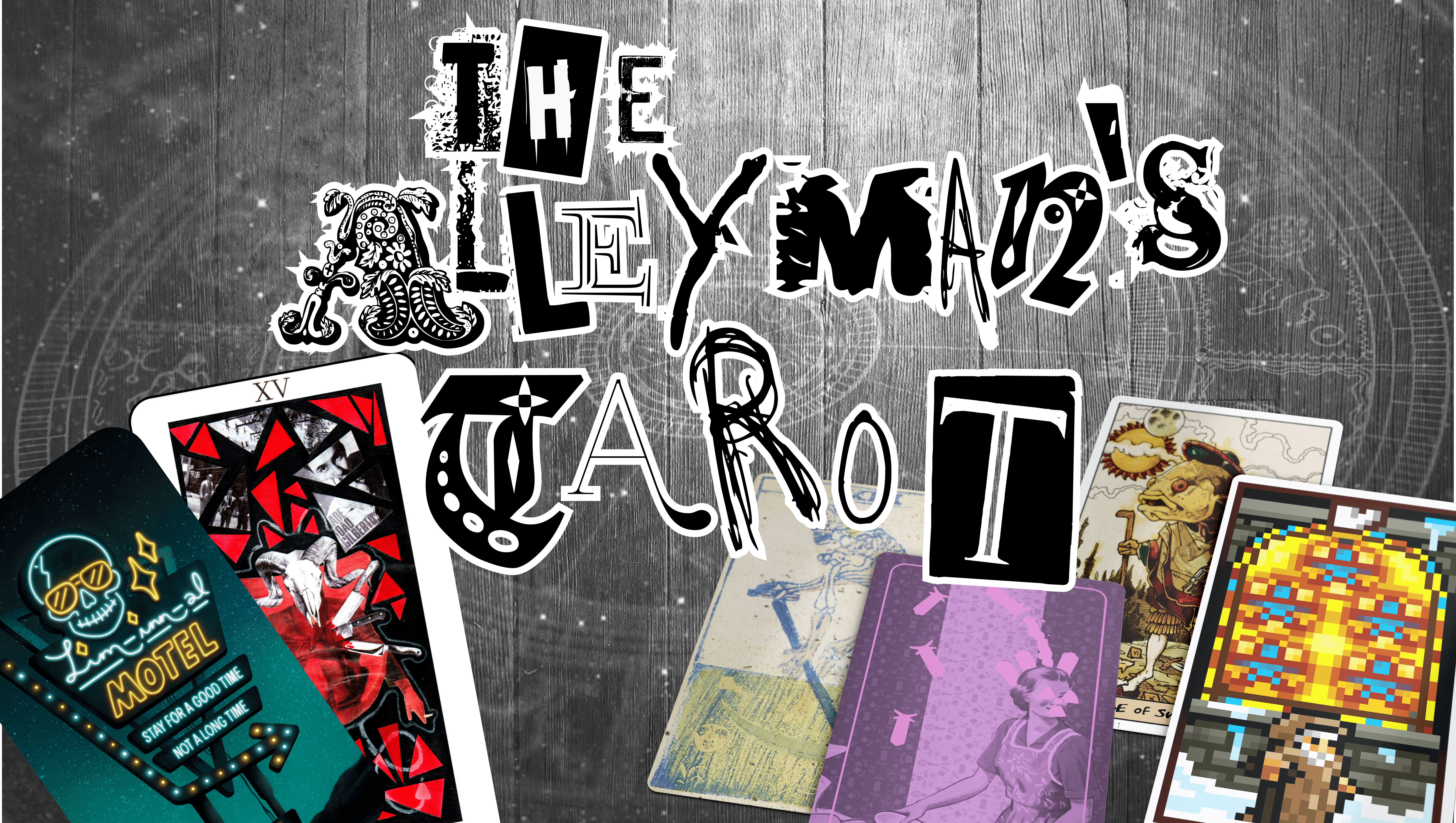Seven Dane Asmund has launched multiple publishing, tarot, and dice crowdfunding projects. However, they never imagined that their latest project would be as successful as it was. The Alleyman’s Tarot, a mismatched tarot deck featuring cards by an impressive lineup of artists, was funded in under 12 hours. By the end of the campaign, it had raised $1,404,172 with 19,275 backers, and is now the most-funded tarot project on Kickstarter. We recently spoke with Asmund about their life-changing campaign, trans visibility in crowdfunding, and the importance of establishing genuine relationships with your community and collaborators as a creator.
What is it about crowdfunding that keeps you coming back?
In short? Crowdfunding is needed to pay my bills. I don’t get enough passive income from my store or online items. It also just feels like more of a “real deal” when you crowdfund. People come together to make it real all at once. There’s a community, repeat backers — it’s just more personal.
How did you get into making tarot cards?
So when I started crowdfunding, I was making TTRPGs (tabletop roleplaying games, like Dungeons and Dragons) and card games. It wasn’t going poorly, but it definitely wasn’t bringing me any income. I reached out to The Caretaker, who runs the Tumblr-famous blog Normal Horoscopes, to ask them if they’d be down with having a book made of their best blog posts. That project became Furiously Prognosticating, the first of my projects to make over $3,000 on Kickstarter.
The Caretaker had been designing (in concept) a strange, 99-card tarot deck that fit their practice. It was just text at that point. They were doing readings on their blog with it, and I thought, “y’know, I’ve made card games already. So why not a tarot deck?” So I floated making the Normal Tarot real [through Kickstarter].
We weren’t sure it would do well at all, but it blew up, passing our recent $4,600 milestone by raising $30,000. From there, we did Normal Tarot 2 with gold and silver foil, and made $130,000. And then here we are with the Alleyman’s, now the most-funded and backed tarot Kickstarter ever. Really strange, abnormal, exponential growth there.
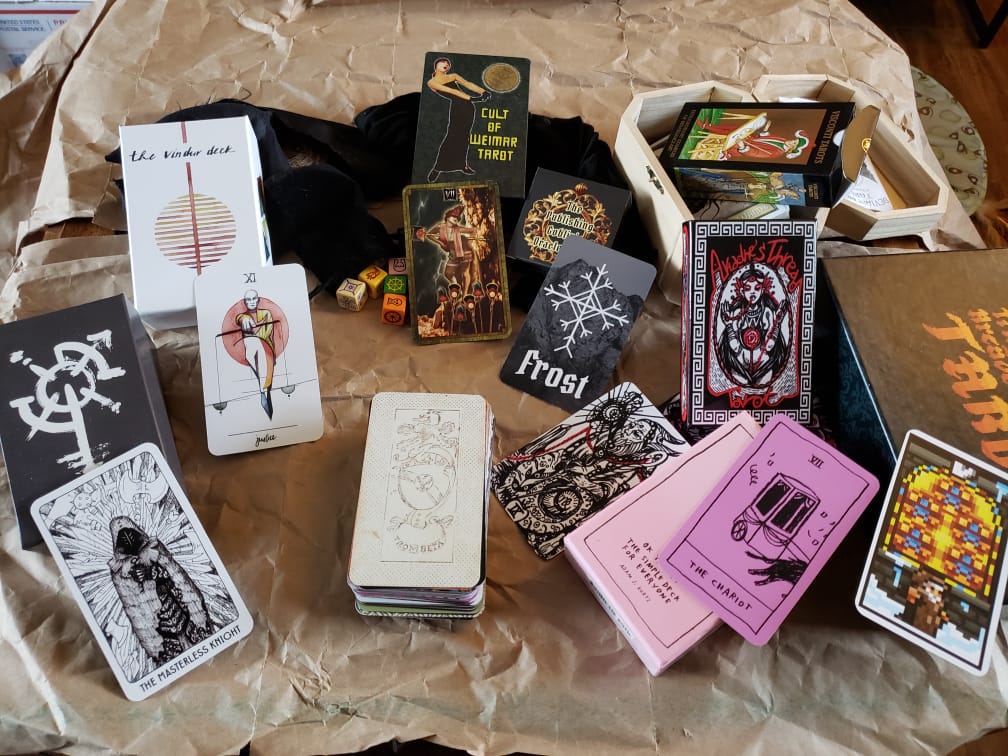
What was the inspiration behind making a mismatched deck?
I like to work in different mediums as much as possible to keep things fresh, so I was going to pen a small, episodic slightly supernatural podcast about the Alleyman, this figure who gives readings from his strange mismatched deck that tell stories about other people, but end up being about the querent. The mythos around him evolved, but I realized I already have literally three card games, a big book TTRPG, three novels, my future Misery Tarot, Oracle Dice, and Divination Coins all in progress. I didn’t need a time sink like a podcast. So I shelved it, but I thought the mismatched deck was so clear in my mind, maybe that would be worth making. The ironic thing here is that the million-dollar stretch goal was to actually make the podcast that I’d originally made this deck for. So now I have to make it anyway.
How did you connect with all of the artists who contributed to The Alleyman’s Tarot?
In the early days of trying to source cards, I could only pretty much get people who didn’t want pay, or for whom the free deck was enough. It was a struggle. I’d search the #tarot tag in Tumblr, DeviantArt, Twitter, ArtStation, Behance, Etsy, and Instagram, looking for cards. I scrolled through all 1200+ tarot projects on Kickstarter and reached out to all the ones that looked like they would fit the process/theme/aesthetic. I knew I had to get a good base of six or so cards that looked super good to show future potential artists or they’d think I had nothing or that I wasn’t serious. And I did!
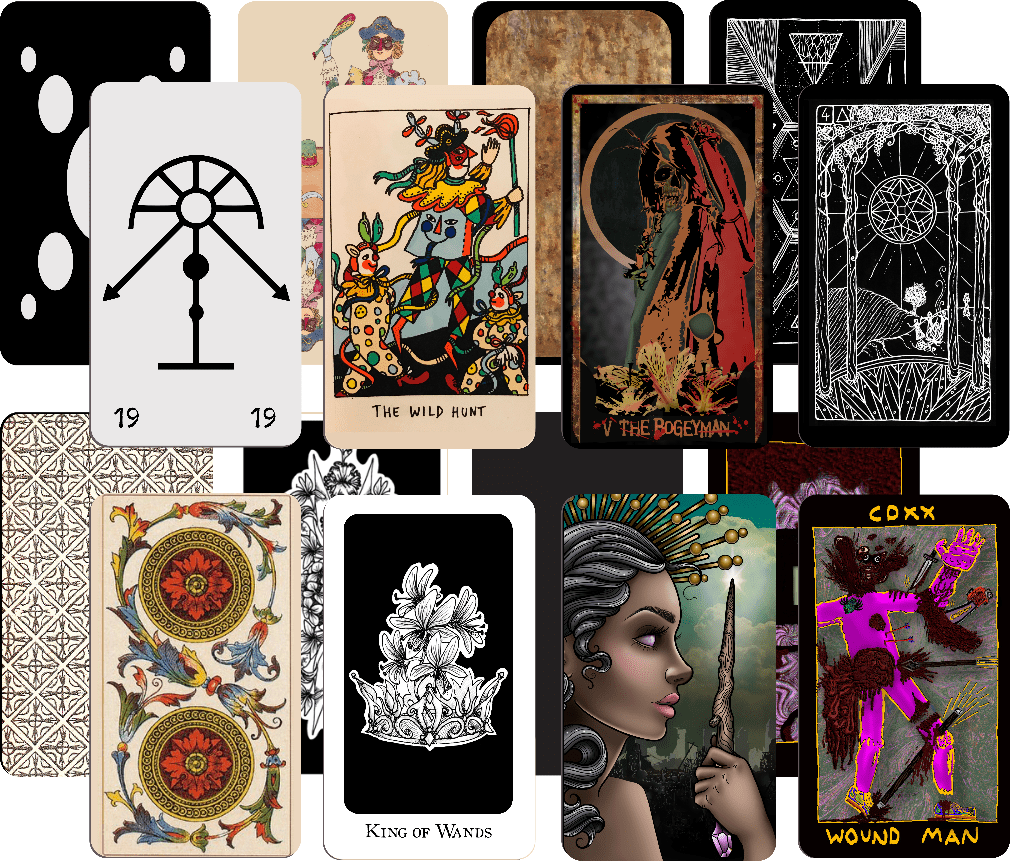
In the early days especially, more people said “no thanks” than said “hell yeah.” It was a total slog. But as I got more and more people, some bigger names started working on the branding and did up the logo, and it seemed more real. Then I got the campaign page up on pre-launch for Kickstarter and people were just more on board. It also helped that around the mid-point of gathering cards, I actually wrote up a full contract. Many artists wanted to see it before deciding anything, which makes sense.
After a year of struggling to get the deck together, the grand irony is that hundreds of people have reached out since it launched trying to get art or cards into it. I was begging for over a year and now I’m turning people away — some of them really cool artists that I just don’t have space for now.
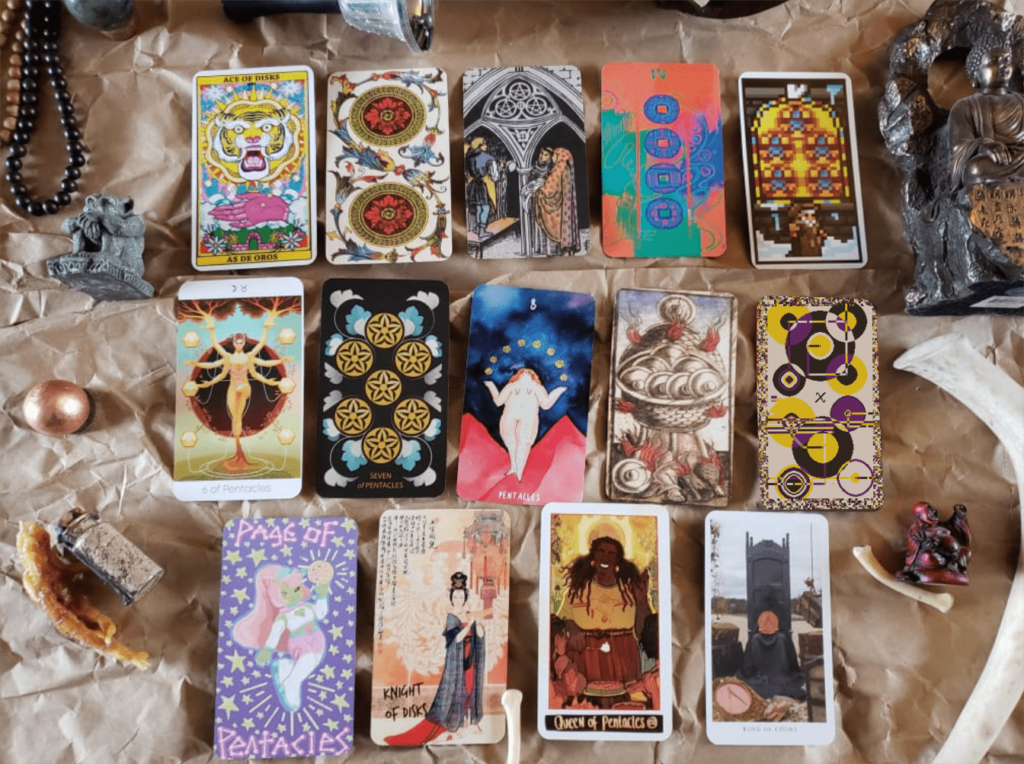
As a repeat crowdfunding creator, how do you keep the community you’ve built over the years engaged?
I’ve always been a one-person project runner. In the early days, I used to personally message a thank you (not copy-pasted at all) to every backer as they pledged. As it got bigger, I couldn’t quite do that, but I’ve always made it a point to reply to every comment and message, and just be casual and open — totally transparent — in every step of the project. I think that has gone miles to ensuring I had fans.
That being said, while my games and TTRPGs grew from project to project, it was small, small, incremental growth. It was The Caretaker, who skyrocketed my campaigns with them. And thanks to that, I had a larger audience from project to project to pull from. I can’t stress enough how important it has been having friends that actually have social media followings, cause I sure don’t.
You mention on The Alleyman’s Tarot campaign page that you’re trans, nonbinary, and queer. There are other trans and queer creators who may be hesitant to share this aspect of themselves publicly. What impact did mentioning this have on your campaign, if any?
I came out as a gay man to everyone when I was around 20. Now at 30, I’m like, “maybe I’m a woman? A straight woman? Something woman-adjacent? Definitely not a man?” It’s the right step in my life, and I realized more than anything, I want to be a public queer person. I didn’t know transgender people existed as a kid. I could have figured all this out as a kid, or a teen, if there had been public trans figures then.
I’ve already talked to a few other trans people (and teens) and got to share with them my experience and what I’ve done and just kind of helped show them that trans people are out here doing things. I have had limited negative feedback, but it’s still been there. I’ve also seen an incredible base of supporters who are correcting other people on my pronouns, which is wild. I’m also sometimes seeing people be corrected and ignore it and go on using he/him. There are definitely two sides to the coin.
If I had known that this would become the most-funded and backed tarot Kickstarter (2 times the backers of any other tarot Kickstarter), I would have made it even more apparent I was queer. People all over think they don’t know or have never met or seen a trans person. But we’re all over. We just usually don’t announce it because we like not being hate crimed or murdered, y’know? I’m white, and I have extreme privilege in that sphere as a trans person, it would be disappointing to have not used this as a platform to at least shout “hey look, trans people are here, making your art! You have met and interacted with us! We’re real!”
As you’ve mentioned, The Alleyman’s Tarot ended up raising over $1 million and being the most-funded tarot project on Kickstarter. What steps did you take in preparing your campaign that led to your immense success?
People keep asking me what I did. I did a series of “How to Run a Kickstarter” posts on Tumblr a year ago that still cover what I do and think is most important. I make sure people know it’s going to happen and when, get them to follow the pre-launch page. Day one is the most important of the whole campaign. But this campaign was lightning, I don’t think I could replicate it if I tried.
On top of what I normally do, this was my first time partnering with Backerkit for advertising from the very start, and I had 83 artists who were contractually obligated to make social media rounds about the campaign on launch day, as close to launch time as possible. The rest was just the right new deck, concept, and product at the right time. People have done collab decks where many artists did cards for one deck, but they try to unify the deck in a theme or style or frame. This was the first and only time a patchwork deck was made. Others will now try, and that’s fine. I hit it just right.
I think it also helps that I always look at how cheaply I can price something. Even though this is my full-time job now, even though I literally need this money to pay bills, I’m just not a very good capitalist. I want to give away free decks, I want to price things close to print-cost. But there was so much overhead on this project with the 83 artists that I had to price the decks at $45. I still did limited $35 and $40 tiers for people who had limited funds, and to people’s credit, there were 600+ backers on the $45 tier before the 35 and 40 tiers were filled.
How did you plan your stretch goals? Were you prepared to take it all the way to $1 million?
Ironically, I have always overplanned my stretch goals. Like, on my projects that make $2,000, I had stretch goals that went up to $100,000. On this project, I had goals all the way up to I think $1,000,000. But before I launched, I finally swallowed my hopes and just made it more realistic, around $300,000 at most I think. Then, in the first 24 hours, we made more than the entire Normal Tarot 2 campaign, and I honestly sighed, knowing I was going to have to write up stretch goals back up to $500,000 or so. Then it just kept growing, and I filled it out up to $1.3 million. It’s hilarious that the campaign where I finally accepted my limitations went beyond anything I could have imagined.
Why did you decide to use BackerKit this time around?
It was no question. The help it offered on the latest project (Normal Tarot 2) was big, and it would have been better if I’d used it from the start. For ads, for backer management (you have so much more control over backers and their cards on BackerKit that Kickstarter doesn’t offer at all), for accepting late pledges, it’s so helpful. It’s also great for taking shipping costs. I’ve just learned that BackerKit smooths out bumps between itself and Kickstarter.
Do you have any advice for experienced creators like you who’ve had success in the past but have set their sights on a more ambitious funding goal?
Be open, honest, make cool art, and share it with the world! Put your focus on getting the art out into the world, value your time properly, but don’t overcharge for things when you could make your art more accessible for people monetarily. I could have priced this at $50 minimum or higher, and no one would have been surprised in the tarot collecting world. This is 2 times the cards of a normal deck. It could have been $100 or something ridiculous. But I went low, made all my add-ons as cheap as possible. Sometimes, when you price fairly, people show up!
Now that The Alleyman’s Tarot is funded, what’s next for you?
With the funds my business is making from this project, I can finally afford to hire on some writers to help me finish writing and fixing my big TTRPG system, which is the core of future TTRPG projects I want to make. I have a podcast to make now, thanks to that $1 million stretch goal. Caretaker and I are working on the Divination Coins, which should make it for an October Kickstarter [launch] if The Alleyman’s Tarot fulfills on schedule). I’m revising a novel that’s the start of a larger series that I’d like to do an official full release of this year, and I started work on a few new games. The coins should happen first, but you never know. It’s non-stop projects over in Publishing Goblin land.
Asmund’s latest project, Publishing Goblin’s Oracle Dice, 2nd Edition, is now live. Check it out on BackerKit today! And if you’d like to read more interviews like this and get crowdfunding advice, make sure to sign up for the BackerKit Community Newsletter.